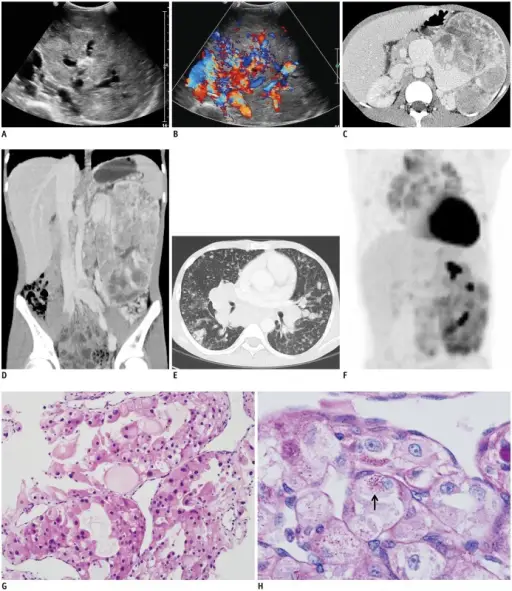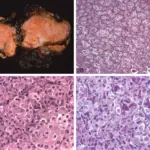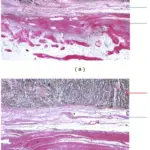
Alveolar Soft Part Sarcoma. Imaging and pathologic findings of alveolar soft part sarcoma arising from kidney in 16-year-old boy.Two-dimensional (A) and Doppler (B) ultrasonographic images show heterogeneously hyperechoic mass in left kidney with internal and peritumoral dilated vascular structures. C, D. Contrast-enhanced CT scan of abdomen. Axial (C) and coronal (D) images show huge enhancing mass with internal necrotic foci, occupying almost whole left kidney. Numerous collateral vessels in addition to renal artery and vein show variceal changes. E. On chest CT with lung window setting, multiple different sized pulmonary nodules and diffuse interlobular septal thickening are noted in both lung fields, suggesting metastasis. F. PET-CT shows inhomogeneous FDG uptakes in large mass of left kidney (max SUV = 6.4) and in mass of small bowel mesentery (max SUV = 3.9). Multiple pulmonary nodules in both lungs and lymphadenopathies of left paraaortic, aortocaval and retrocrural regions, right supraclavicular region, mediastinum and in both perihilar regions showed FDG uptakes. FDG = fluorodeoxyglucose, max SUV = maximum standardized uptake value, PET = positron emission tomography. G. Epithelioid tumor cells arranged in nests contain abundant eosinophilic cytoplasm (H&E, × 200). H. Tumor cells exhibit prominent periodic acid-Schiff (PAS)-positive, rod-shaped crystals (arrow) in cytoplasm (PAS Stain with diastase, × 1000). Alveolar soft part sarcoma arising from the kidney: imaging and clinical features. Kim JM, Im SA, Oh SN, Chung NG - Korean journal of radiology (2014). Not Altered. CC.
Alveolar soft part sarcoma is a rare, slow-growing soft-tissue tumor of an unclear cause.
What is the Pathology of Alveolar Soft Part Sarcoma?
The pathology of alveolar soft part sarcoma is:
-Etiology: The cause of alveolar soft part sarcoma is unknown.
-Genes involved: ASPL and TFE3.
-Pathogenesis: The sequence of events that lead to alveolar soft part sarcoma includes the chromosomal analysis which shows the breaking and joining of two chromosomes in the tumor cells.
-Histology: The histology associated with alveolar soft part sarcoma shows well-defined nests of cells separated by fibrous stroma.
How does Alveolar Soft Part Sarcoma Present?
Patients with alveolar soft part sarcoma typically affect young females at an age range of 30 years. The symptoms, features, and clinical findings associated with alveolar soft part sarcoma include a painless swelling, or soreness caused by compressed nerves or muscles, affecting the range of motion in the area.
How is Alveolar Soft Part Sarcoma Diagnosed?
Alveolar soft part sarcoma is diagnosed by imaging scans such as CT or MRI.
How is Alveolar Soft Part Sarcoma Treated?
Alveolar soft part sarcoma is treated by surgery combined with radiation therapy.
What is the Prognosis of Alveolar Soft Part Sarcoma?
The prognosis of alveolar soft part sarcoma is poor.



